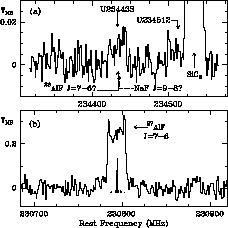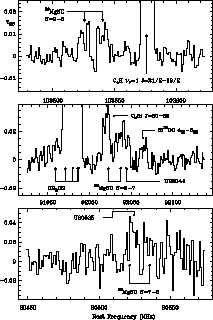



Next: CO in the
Up: Scientific Results
Previous: Scientific Results
M. Guélin , M. Forestini
, M. Forestini , P. Valiron
, P. Valiron , L. M. Ziurys
, L. M. Ziurys , M.A. Anderson
, M.A. Anderson , J. Cernicharo
, J. Cernicharo , C. Kahane
, C. Kahane
 IRAM, 300 rue de la piscine, F-38406 S
IRAM, 300 rue de la piscine, F-38406 S Martin d'Hères,
France
Martin d'Hères,
France
 Laboratoire d'Astrophysique, Observatoire de Grenoble,
BP 53, F-38041 S
Laboratoire d'Astrophysique, Observatoire de Grenoble,
BP 53, F-38041 S Martin d'Hères Cedex 09, France
Martin d'Hères Cedex 09, France
 Arizona State University, Dept. of Chemistry, Tempe, AZ 85287-1604, USA
Arizona State University, Dept. of Chemistry, Tempe, AZ 85287-1604, USA
 Centro Astronomico de Yebes, IGN, E-19080 Guadalajara, Spain
Centro Astronomico de Yebes, IGN, E-19080 Guadalajara, Spain
Abstract: We report the detection in the circumstellar envelope IRC+10216 of
millimeter lines of the rare isotopomers  NC and
NC and
 NC, as well as of a line at 234433 MHz, which could be
the J= 7--6 transition of
NC, as well as of a line at 234433 MHz, which could be
the J= 7--6 transition of
 F (an alternate, although less likely identification would be the
J= 9--8 transition of NaF). The derived
F (an alternate, although less likely identification would be the
J= 9--8 transition of NaF). The derived
 :
: :
: isotopic abundance ratios (
isotopic abundance ratios ( ) are consistent with the solar system values
(78.7:10.1:11.2). According to new calculations of evolutionary
models of
) are consistent with the solar system values
(78.7:10.1:11.2). According to new calculations of evolutionary
models of  and
and  AGB stars, these ratios and the
previously measured N, O and Si isotopic ratios imply that the central
star had an initial mass
AGB stars, these ratios and the
previously measured N, O and Si isotopic ratios imply that the central
star had an initial mass 

 and has
already experienced many 3
and has
already experienced many 3 dredge-up events. From this, it
can be predicted that the
dredge-up events. From this, it
can be predicted that the  /
/ isotopic ratio
lies between 0.01 and 0.08; in fact, the value derived in the case
U234433 arises from
isotopic ratio
lies between 0.01 and 0.08; in fact, the value derived in the case
U234433 arises from  F is
F is  /
/ =
0.04.
=
0.04.

Figure: Two spectra, observed toward IRC+10216 with the IRAM 30-m
telescope, and covering the frequencies of the J= 7--6 transitions
of  F (top) and
F (top) and  F (bottom). The
channel width is 1 MHz. The position and strength of the
F (bottom). The
channel width is 1 MHz. The position and strength of the
 F line hyperfine components are denoted by vertical
lines. U234433 lies only 0.9 MHz below the calculated frequency of
F line hyperfine components are denoted by vertical
lines. U234433 lies only 0.9 MHz below the calculated frequency of
 F (7--6) and could well be this line; an alternate, but
less likely identification is the J= 9--8 line of NaF, the rest
frequency of which is 234435.2 MHz.
F (7--6) and could well be this line; an alternate, but
less likely identification is the J= 9--8 line of NaF, the rest
frequency of which is 234435.2 MHz.

Figure:
The N= 7--6 through N= 9--8 rotational lines of  NC in
IRC+10216. The channel width is 1 MHz
NC in
IRC+10216. The channel width is 1 MHz
The identification of the  NC and
NC and  NC lines
was made possible by ab-initio quantum mechanical calculations
of the molecule geometrical structure. It was confirmed through
millimeter-wave laboratory measurements. The quantum mechanical
calculations are briefly described and the laboratory results
presented in some detail. The rotation constants B, D, H and the
spin-rotation constant
NC lines
was made possible by ab-initio quantum mechanical calculations
of the molecule geometrical structure. It was confirmed through
millimeter-wave laboratory measurements. The quantum mechanical
calculations are briefly described and the laboratory results
presented in some detail. The rotation constants B, D, H and the
spin-rotation constant  of
of  NC and
NC and
 NC, and the hyperfine constants b and eqQ of
NC, and the hyperfine constants b and eqQ of
 NC are determined from a fit of laboratory and
astronomical data.
NC are determined from a fit of laboratory and
astronomical data.
Accepted by Astronomy and Astrophysics
(For preprints, contact guelin@iram.fr)




Next: CO in the
Up: Scientific Results
Previous: Scientific Results
Robert Lucas
Thu Mar 9 12:42:24 MET 1995

 F (top) and
F (top) and  F (bottom). The
channel width is 1 MHz. The position and strength of the
F (bottom). The
channel width is 1 MHz. The position and strength of the
 F line hyperfine components are denoted by vertical
lines. U234433 lies only 0.9 MHz below the calculated frequency of
F line hyperfine components are denoted by vertical
lines. U234433 lies only 0.9 MHz below the calculated frequency of
 F (7--6) and could well be this line; an alternate, but
less likely identification is the J= 9--8 line of NaF, the rest
frequency of which is 234435.2 MHz.
F (7--6) and could well be this line; an alternate, but
less likely identification is the J= 9--8 line of NaF, the rest
frequency of which is 234435.2 MHz.



 , M. Forestini
, M. Forestini , P. Valiron
, P. Valiron , L. M. Ziurys
, L. M. Ziurys , M.A. Anderson
, M.A. Anderson , J. Cernicharo
, J. Cernicharo , C. Kahane
, C. Kahane
 IRAM, 300 rue de la piscine, F-38406 S
IRAM, 300 rue de la piscine, F-38406 S Martin d'Hères,
France
Martin d'Hères,
France Laboratoire d'Astrophysique, Observatoire de Grenoble,
BP 53, F-38041 S
Laboratoire d'Astrophysique, Observatoire de Grenoble,
BP 53, F-38041 S Martin d'Hères Cedex 09, France
Martin d'Hères Cedex 09, France Arizona State University, Dept. of Chemistry, Tempe, AZ 85287-1604, USA
Arizona State University, Dept. of Chemistry, Tempe, AZ 85287-1604, USA Centro Astronomico de Yebes, IGN, E-19080 Guadalajara, Spain
Centro Astronomico de Yebes, IGN, E-19080 Guadalajara, Spain  NC and
NC and
 NC, as well as of a line at 234433 MHz, which could be
the J= 7--6 transition of
NC, as well as of a line at 234433 MHz, which could be
the J= 7--6 transition of
 F (an alternate, although less likely identification would be the
J= 9--8 transition of NaF). The derived
F (an alternate, although less likely identification would be the
J= 9--8 transition of NaF). The derived
 :
: :
: isotopic abundance ratios (
isotopic abundance ratios ( ) are consistent with the solar system values
(78.7:10.1:11.2). According to new calculations of evolutionary
models of
) are consistent with the solar system values
(78.7:10.1:11.2). According to new calculations of evolutionary
models of  and
and  AGB stars, these ratios and the
previously measured N, O and Si isotopic ratios imply that the central
star had an initial mass
AGB stars, these ratios and the
previously measured N, O and Si isotopic ratios imply that the central
star had an initial mass 

 and has
already experienced many 3
and has
already experienced many 3 dredge-up events. From this, it
can be predicted that the
dredge-up events. From this, it
can be predicted that the  /
/ isotopic ratio
lies between 0.01 and 0.08; in fact, the value derived in the case
U234433 arises from
isotopic ratio
lies between 0.01 and 0.08; in fact, the value derived in the case
U234433 arises from  F is
F is  /
/ =
0.04.
=
0.04.

 NC in
IRC+10216. The channel width is 1 MHz
NC in
IRC+10216. The channel width is 1 MHz NC and
NC and  NC lines
was made possible by ab-initio quantum mechanical calculations
of the molecule geometrical structure. It was confirmed through
millimeter-wave laboratory measurements. The quantum mechanical
calculations are briefly described and the laboratory results
presented in some detail. The rotation constants B, D, H and the
spin-rotation constant
NC lines
was made possible by ab-initio quantum mechanical calculations
of the molecule geometrical structure. It was confirmed through
millimeter-wave laboratory measurements. The quantum mechanical
calculations are briefly described and the laboratory results
presented in some detail. The rotation constants B, D, H and the
spin-rotation constant  of
of  NC and
NC and
 NC, and the hyperfine constants b and eqQ of
NC, and the hyperfine constants b and eqQ of
 NC are determined from a fit of laboratory and
astronomical data.
NC are determined from a fit of laboratory and
astronomical data.